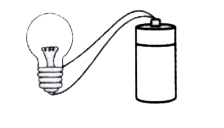(a) what is the rate at which energy being delivered to a light bulb higher : just after it is turned on , the glow of the filament is increasing , or after it has been on for a few seconds and the glow is steady ?
(b) IF a piece of wire is used to connect points bandc in Fig. 7.9, does the brightness of bulb R1 increase , decrease or stay constant ? What happens to the brightness of bulb R2 ? (I1=I2=I)
(c) Compare the brightness of four identical light bulbs in Fig.7.10. What happens if the bulb A fails so that it cannot conduct ? What if C fails ? What if D fails?
(d) If electric power is transmitted over long distances, the resistance of the wires becomes significant. Why ? Which mode of transmission would result in less energy losss: high current and low voltage or low current and high voltage ? Discuss.
(e) In Fig.7.11, describe wha happens to the light bulb after the switch is closed . Assume the capacitor has a large capacitance and is initially uncharged.
(f) Astuident claims that a second light bulb in series is less bright than the first , because the first bulb uses up some of the current . How would you respond to this statement ?
(g) If you were to design an electeric heater using nichrome wire as the heating element , what parameters of the wire would you vary to meet a specific power output , sch as 1000W?



Video Solution
Text Solution
(a) Just after it is turned on , the energy supplied to the bulb is higher . Becsause initially resistance is low and it increases with the increase in temperature.
(b) After connecting bandc, R2 will be short - circuited . Hence , it will not glow. Now , entire potential difference will be on R1. So brightness of R1 increases.
(c) D is short - circuited, so D will not glow. Potential difference across C is V, so potential difference across each of AandBisV/2. So brightness of C is the greatest and that of AandB are equal.
If A fails, B will not glow. No effect on CandD.
IF C fails , C will not glow. No effect on A,B,andD.
IF D fails , no effect anywhere.
Because resistance is directly proportional to length , at low current and high voltage energy , loss will be less. Because if current is less , then loss of energy I2R will be less.
(e) Initially , current will be high in the circuit , so bulb will glow with maximum possible brightness of the bulb falls and finally the bulb goes out.
(f) This is not true. Because in series, current through all the bulbs is the same. The current is simultaneously set up is series through all the bulbs.
(g) P=V2R=v2Apl
Here, P and V are fixed. We can vary A or l.
|
Topper's Solved these Questions
- HEATING EFFECT OF CURRENTBook:CENGAGE PHYSICSChapter:HEATING EFFECT OF CURRENTExercise:Subjective
Explore 8 Videos
- HEATING EFFECT OF CURRENTBook:CENGAGE PHYSICSChapter:HEATING EFFECT OF CURRENTExercise:Single Correct
Explore 60 Videos
- HEATING EFFECT OF CURRENTBook:CENGAGE PHYSICSChapter:HEATING EFFECT OF CURRENTExercise:Solved Examples
Explore 13 Videos
- GRAVITATIONBook:CENGAGE PHYSICSChapter:GRAVITATIONExercise:Question Bank
Explore 39 Videos
- INDUCTANCEBook:CENGAGE PHYSICSChapter:INDUCTANCEExercise:Concept Based
Explore 9 Videos
Similar Questions
Knowledge Check
Statement-I: The power delivered to a light bulb is more just after it is switched ON and the glow of the filament is increasing as compared to when the bulb is glowing steadily, i.e. after sometime of switching ON. Statement-II: As temperature decreases, resistance of conductor increases
AIf both Statement- I and Statement- II are true, and Statement - II is the correct explanation of Statement– I.BIf both Statement - I and Statement-II are true but Statement - II is not the correct explanation of Statement – I.CIf Statement-I is true but Statement-II is falseDIf Statement-I is false but Statement-II is true.In which case does the bulb glow ?
A B
B C
C D
D
Of the two bulbs , one glows brighter than the other . Which bulb has a higher resistance ?
ABrightness is independent of resistanceBThe bright bulbCBoth have the same resistanceDThe dim bulb
When an electric bulb glows
View SolutionA student connected the terminals P and Q by a piece of thread. Will the bulb glow?

View SolutionDecrease In The Brightness Of Bulb After Long Use
View Solution(a) How does the wire in the filament of a light bulb behave differently to the other wires in the circuit when the current flows?
(b) What property of the filament wire accounts for this difference?
View SolutionWhy does an electric bulb does not glow even it is connected to the cell ?
View Solution
